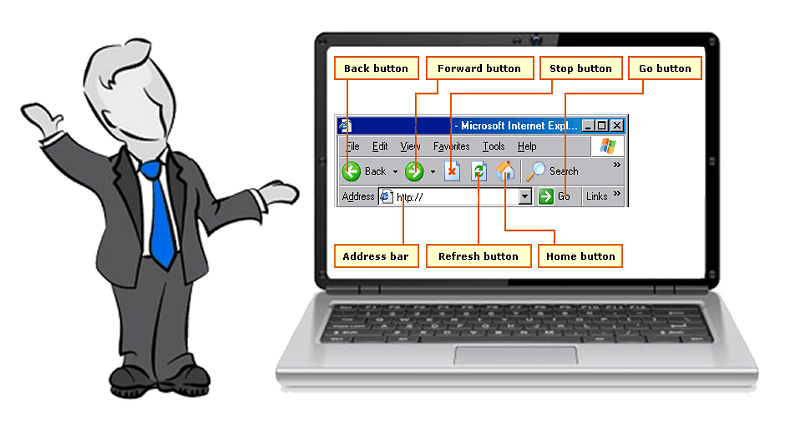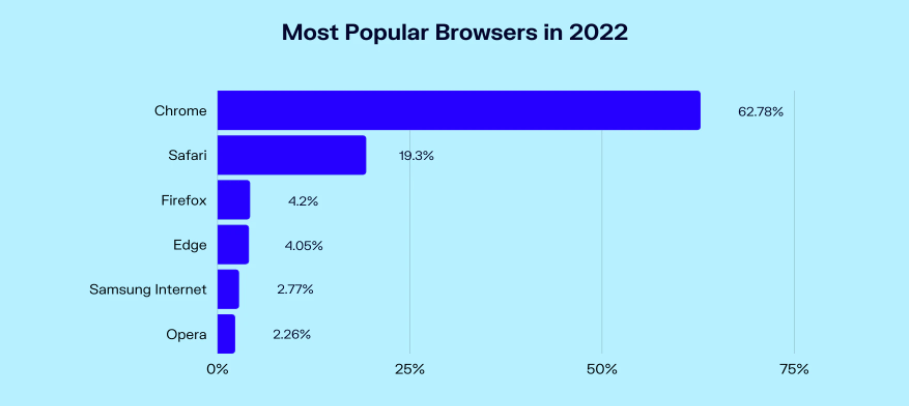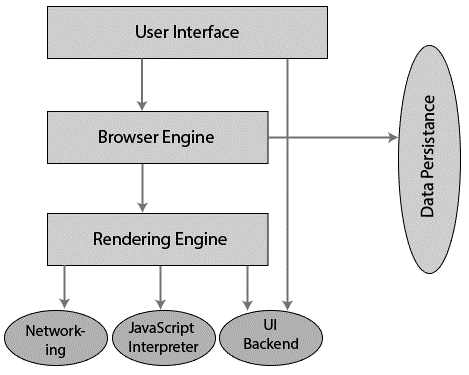What is a Web Browser?
Web browser is a powerful software that enables the user to efficiently access the world wide web. It allows the user to access the data and information available on the internet. There are all kinds of information available on the world wide web ranging from texts, images, and videos. The user can explore and retrieve that information easily by using the web browser. The word browser is derived from the word browse, which means searching or navigating. The word browser was not initially used for the web browser. Rather, it refers to the user interface that allows users to surf the web. The web browser is the collection of numerous web pages linked together using hyperlinks. They are a means to establish a client-server network on the internet, where the client requests the information provided to it by the webserver. Protocols govern the web browser to perform various functions on the world wide web.
History of the Web Browser

Tim Berners-Lee developed the first browser to access the world wide web in 1990. This was called WorldWideWeb. The name was confusing, so it was renamed Nexus. In 1992, another browser called Lynx was developed, but this browser did not support graphical content and could only be used to navigate text-based data. Mosaic was the first web page with a graphical interface developed in 1993.
Due to the user interface, this web browser became quite popular. In 1995, Microsoft developed its web browser, the internet explorer. Then, Apple followed Microsoft to develop its web browser known as Safari. Google Chrome, one of the most popular web browsers, was developed in 2008. The Internet Explorer of Microsoft was quite slow compared to the other web browsers available. So, Microsoft launched the Edge browser in 2015.
Features Common to all Web Browsers
- Home Page: The home page is defined by the web developer when the web pages are developed. Generally, it is the first introductory page of the website. This button redirects the user to that page.
- Refresh: When refreshing the browser, the entire web page is reloaded again from scratch. All the cache memory is lost, which increases the browser's speed. Any update made on the web page after the initialization of the browser will be lost.
- Web Address Bar: This bar is available at the top of the website; it displays the current web page's address. The user can also input a web address to directly redirect to the particular website.
- Back and Forward website: As the name suggests, these websites enable users to visit the last page or the next page.
- Stop: It terminates all the loading processes performed on the current webpage. The communication is abruptly interrupted between the world wide web and the system.
- Bookmarks: This enables the user to store the address of some websites for easy retrieval of the site. The user can store frequently used websites.
- Tabs: This will display the number of websites currently open in the browser. On clicking the tabs, it will show the list of open websites.
- Plug-ins: These are the extensions to the features of the current browser. They can be installed on the browser to add functionality to it. They can be used to increase security.

Working on the Web Browser
Any website on the world wide web follows the client-server architecture. The web browser is available at the client-end. Using the web browser user requests the server for information. The server provides the requested information to the browser, which is then interpreted and displayed to the user. A web browser consists of several modules that are interconnected and work simultaneously. It provides a graphical user interface at the view level of the application. It is the part visible to the end-user. The browser engine sends the request to the rendering engine, which then accepts the request and renders the requested result to the browser.
The web pages are usually HTML or XML documents interpreted by the engine. Networking is responsible for the communication between various devices on the network; it also ensures that the network established is secure for sharing information. It also has additional storage for storing the bookmarks, and cookies. This layer is called the persistence layer.
Some of the Popular Web-Browser

Google Chrome: Currently, the most used web browser is Google Chrome, with approximately a market share. Sixty-two per cent, which means every 6 out of 10 internet users access the world wide web using the Chrome web browser.
Safari: It is the second most popular web browser exclusively available to Apple product users. It comprises almost 20 per cent of the global market.
Firefox and Microsoft Edge: They are the next two popular web browsers. They comprise a 4 per cent share each in the global market. The Microsoft Edge comes pre-installed on all Windows computers and the Microsoft Office Suite.
Flock: It is an advanced web browser exclusively optimized to efficiently use social media and blogging tools.
Components of a Web Browser
Certain components are essential for the proper working of a web browser:
- User Interface: This defines the view available to the end-user. It may also vary from user to user. It contains all the features that are essential to the user. The user interface should be easy for a browser to be popular. It may include features such as bookmarks, cookies and recommendations. The working of the user interface should be as simple as possible.
- Browser interface: It acts as a bridge between the front-end and the back-end of the website. The browser interface is a medium between the external view and the engine responsible for rendering the services to the user. It translates the enquiry done by the user into query language that the engine can understand.
- Rendering Engine: It is the part that handles the back-end operations in the web browser, which includes searching and displaying the content. It answers the request of the user. Its functions include the translation of website languages such as HTML, CSS, and XML that describe the structure and representation of the website. It also defines the layout of the website and the view of the website visited by the user. It can also be used with extensions and plugins.
Web browsing engines used by the various websites:
- Chrome uses different extensions for different operating systems, is Webkit for iPhone and Blink for the rest operating systems.
- Mozilla browsers use Gecko.
- Networking: This component deals with the connection and the protocols that each party on the internet need to abide by to access the internet. This component is responsible for retrieving the resource locations in a web browser. To retrieve the URL of a website, it uses protocols such as HTTP or FTP. It can increase the security and speed of the internet. The frequently visited document can be added to the cache to reduce the load on the network.
- JavaScript Interpreter: It is a scripting language responsible for the responsiveness and functionality of the browser. It cannot be translated along with HTML and CSS using a rendering engine; to translate and execute the JavaScript code, its interpreter is separately installed in the browser that enables the user to operate on the website during the runtime. The output of the code is passed to the rendering engine, which then displays the result on the website.
- UI Backend: Unlike the user-specific user interface, the interface at the back-end level is generic. It includes the widgets and basic drop-down menus and draws basic combo boxes.
- Data Storage: This allows the user to store the data in the local memory that is managed by the browser itself. This layer is used as a persistence layer. The cookies, session and autofill form all these features are possible because of the presence of a persistence layer in the web browser. Different web browsers use different data management systems to store the data. The data is stored in the system's local drive that is accessible by the browser. It is responsible for managing the saved data, cookies, bookmarks and recommendations.

Address of a Website
The address of the webpage enables the user to locate the specific webpage using the web browser. We refer to this address as the Uniform Resource Location of the webpage. It addresses the resource and is unique to that particular resource only. Just by knowing the address of the webpage, we can determine various features of the webpage, such as:
- The protocol is used to access the webpage.
- The website's domain name can tell the nature of the scope of the website.
- The exact location of the file in the server and the location of the server itself.
Various Web Browsers
Google Chrome: It is currently the most popular web browser. It is an open-source web browser developed by Google in 2008. The reason behind its popularity is its user-friendly design and optimum performance. It was the first browser that combined the search and address bar. It is a reliable and secure web browser.
The link to the website to download Google Chrome is given below:
https://www.google.com/chrome/
Opera: It was primarily designed as a web browser for desktop systems, but the mobile version of the web browser became more popular than the one for desktops. It uses the blink browsing engine to determine the layout of the web pages. Opera Software purchased it from the Telenor Company.
The download link for Opera is provided below:
Safari: It was launched by Apple in 2003. It is currently the second most popular web browser and comes pre-installed on all Apple devices. It uses the Webkit browsing engine that determines the website's structure, design, and responsiveness.
To download the Safari browser for your system, type the link given below: https://support.apple.com/downloads/safari